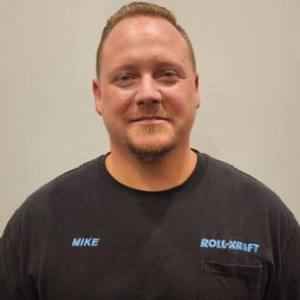Subscribe To Roll-Kraft
Receive the latest news from Roll-Kraft.

Ideally, a roll forming system should produce parts at a scrap rate of 0-5%. If your scrap rate is higher than 5%, efforts should be taken to investigate the causes and to take corrective actions. The main causes for scrap are:
Other causes for increased levels of scrap can be attributed to the complexity of the profile, pre-punching or notched features and cut off related problems. These issues are considered less common and require specific details not covered here (check our technical resources section of our website for additional information). This article will cover the main causes for scrap and preventative and corrective actions to minimize it.
Causes for excessive scrap (can be a combination of these):
 Is the main cause of your scrap due to the incoming steel?
Is the main cause of your scrap due to the incoming steel?
The saying “junk in, junk out,” is true in many cases. Excessive camber, crown, oil-canning, cross-break, coil set, burred or damaged edges in the coiled material greatly effects the consistency of the roll form production line and specifically to the roll formed cross section. Material defects as mentioned are caused for various reasons in the post processing of the steel, but your production line personnel can make basic measuring and visual inspections of the incoming coils and develop standards that work for the specific roll set and product. In other words, coiled material will always have one or more of these abnormalities and a good tooling design combined with specific setup procedures for each defect scenario will result in acceptable parts and scrap rates while avoiding the most extreme defects by rejecting the worst material before it is ever used.
One other variable that must be mentioned is the incoming steel that is procured from multiple sources. Inconsistencies in mechanical and chemical properties of the steel purchased from multiple sources are often unseen using common inspection techniques, but will become apparent when the parts are being produced. Large variations in these properties create scrap due to cross-sectional or linear (straightness) problems and downtime caused by trial and error adjustments required to “chase” these material inconsistencies.
Tips to improve consistency of incoming steel:
Is your tooling set causing you the most amount of scrap? 
While the quality of the incoming steel is very important, tooling design, the setup and condition of the roll set contributes greatly to the amount of scrap produced. Too often, scrap produced from a typical tool set is due from the lack of using documented setup charts and settings or from secondary adjustments made by operators on-the-fly after the initial setup does not work. If faced with high amounts of scrap due to the tooling, a process of elimination is needed to determine the corrections needed to minimize it.
Tips to determining and reducing the amount of scrap due to the roll tooling:
 Tooling wear contributes to increased levels of scrap. Occurring gradually over time, as the tooling wears, the start up scrap rate will also increase. Conduct an inspection by first looking for wear to the inside bends of the rolls. These areas are the main wearing points, and can be checked by using radius gages. Wear on the top portions of the flange rolls normally appears as grooves. Either replace these worn segments or consider re-grinding the roll contours to remove the worn areas.
Tooling wear contributes to increased levels of scrap. Occurring gradually over time, as the tooling wears, the start up scrap rate will also increase. Conduct an inspection by first looking for wear to the inside bends of the rolls. These areas are the main wearing points, and can be checked by using radius gages. Wear on the top portions of the flange rolls normally appears as grooves. Either replace these worn segments or consider re-grinding the roll contours to remove the worn areas. Do you see a variation in scrap rates from one shift to another?
We hear this issue all the time and although it seems like a simple problem to fix, it continues to plague many companies. It comes down to three main causes; lack of documented setup procedures, differences between shift operator techniques and the operators’ experience or skill level.
Tips to reducing scrap by incorporating setup and training procedures:
Do mill related problems cause excessive scrap?
 Another culprit to unsatisfactory scrap rates is the alignment and maintenance of the rolling mill. Common problems such as spindle shoulder misalignment, bent spindles and spindle deflection cause numerous product defects that are difficult to trace and result in inconsistent setups from one run to the next. A tooling set is machined to specific tolerances and if the machine is not properly aligned, the rolls cannot operate as designed. Bent spindles and spindle deflection are also common problems and are both related to excessive force being applied to the material to achieve a proper bend.
Another culprit to unsatisfactory scrap rates is the alignment and maintenance of the rolling mill. Common problems such as spindle shoulder misalignment, bent spindles and spindle deflection cause numerous product defects that are difficult to trace and result in inconsistent setups from one run to the next. A tooling set is machined to specific tolerances and if the machine is not properly aligned, the rolls cannot operate as designed. Bent spindles and spindle deflection are also common problems and are both related to excessive force being applied to the material to achieve a proper bend.
Tips to maintaining your roll forming mill to reduce scrap:
Find more roll forming articles here.
Simply contact us here or call and get answers 24/7.
Contact Us (888) 953-9400
Roll-Kraft is pleased to announce the appointment of Mr. Mike Samplak to the position of Plant Manager at its headquarters facility in Mentor, OH.

Roll-Kraft is pleased to announce the appointment of Frank Lowery to Vice President of Roll Form Applications.

Roll-Kraft is pleased to announce the appointment of Kevin Gehrisch to the position of President.